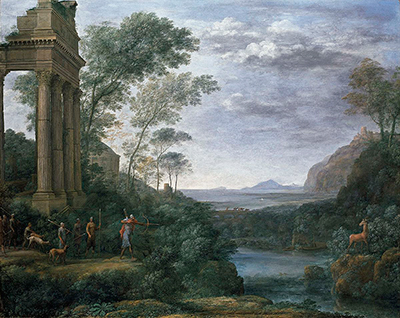Landscape with Ascanius Shooting the Stag of Sylvia was completed by French landscape painter, Claude, in 1682. Today it resides at the prestigious Ashmolean Museum in Oxford, UK.
By this point the artist had been working with a consistent style for several decades and had become regarded as one of the finest artists in Europe. He enjoyed regular commissions from Kings and Popes, among others, and chose to avoid too much experimentation in order to protect the progress that he had made. One cannot see any major stylistic changes within Landscape with Ascanius Shooting the Stag of Sylvia from items that appeared as far back as the 1640s. Prior to that, it must be said, that Claude did evolve considerably as he was developing as a young painter. Within this particular painting we see the rolling hills and mountains, the bright sky scene, and also the more subtle use of figurative art which all underlined where this artist's skills lied. He mastered landscape art techniques very quickly and understandably relied on this genre to bring him success. Figurative art he found more tricky and despite continued attempts to improve, he eventually decided that it was best to avoid enlarging his figures too much.
Within this piece we see a group of figures on one side of the river, with one pointing an arrow menacingly at a deer who looks back at his opponent. A narrow river trickles past between them and slowly leads off into the distance. This group of hunters are towered over by some tall architecture to the left hand side which features several stunning pillars which remind us of classical times. Claude spent much of his life living in Rome, where such styles would have come to his attention frequently. In other paintings he would feature castles, bridges and other buildings in much the same style. Around the figures and the building is a wealth of greenery, where nature is allowed to dominate most of the composition. Behind the mass of green we then see some mountains in the far distance as well as a bright sky above,. The clouds here are slightly more detailed than he would have done earlier in his career, perhaps suggesting just a small amount of evolution.
The Ashmolean Museum in Oxford hosts this piece and also serves British and European art very well across the rest of its display. Claude inspired many British landscape painters and so it is entirely right that he is to be found within the country, with many more of his paintings to be found at the National Gallery in London. In the centuries that followed on after Claude, the UK boomed in the genre of landscape art and much of this was a direct result of the achievements of this important French painter. He was collected and displayed around the UK with great enthusiasm, allowing a number of young artists to study his work in person. This influence has never been forgotten and the influence would later spread back across to France with the Impressionists, some of whom had studied some of the British artists in great detail.




